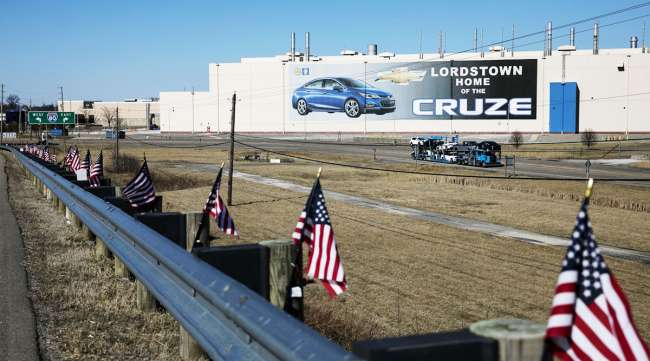News of GM Plant Sale Leaves Union Unhappy

When President Donald Trump tweeted that General Motors Co. was on the verge of selling its idled car plant in Lordstown, Ohio, to a tiny electric truckmaker, David Green had no idea it was coming.
The president of United Auto Workers Local 1112 in Lordstown — whom Trump attacked on Twitter two months ago — is among a handful of workers whose job is to do maintenance at the inactive compact car factory that made its last Chevrolet Cruze in March. He was left in the dark about GM’s talks to sell the factory.
“I haven’t heard anything about it,” Green said by phone May 8. “I’m out in the plant cleaning.”
Shortly after that conversation, GM confirmed it was in discussions with Workhorse Group Inc. to sell the 6.2 million-square-foot assembly plant it opened in 1966. UAW wasted little time making its position clear: They aren’t interested in such a deal.
UAW’s intransigence is just one of a host of reasons to pump the brakes before celebrating GM and Workhorse’s talks as great news for Ohio, as Trump did — in all caps — on Twitter. One analyst immediately questioned whether Workhorse has the financial wherewithal to acquire the plant. And with just 105 employees on staff at the end of last year, the odds are long that the Cincinnati-based company will bring Lordstown back to employing thousands of workers anytime soon, if ever.
....in 3 separate locations, creating another 450 jobs. I have been working nicely with GM to get this done. Thank you to Mary B, your GREAT Governor, and Senator Rob Portman. With all the car companies coming back, and much more, THE USA IS BOOMING! — Donald J. Trump (@realDonaldTrump) May 8, 2019
“In response to General Motors’ announcement today, the UAW’s position is unequivocal: General Motors should assign a product to the Lordstown facility and continue operating it,” Terry Dittes, a UAW vice president and director of its GM department, said in a statement.
Judging from UAW’s initial response, GM and Trump are going to have a hard time painting a future sale to money-losing Workhorse as a win, said Harley Shaiken, a labor relations professor at University of California-Berkeley.
GM is contractually prevented from closing or selling the plant until its current four-year labor deal with UAW expires in September. The union probably will use the sale as leverage on other issues, rendering talks that were already expected to be contentious even testier.
With just $763,000 in sales last year, Workhorse probably is a virtual unknown to GM’s union workers. The maker of electric pickup trucks and delivery vans lost $36.5 million in 2018 and secured $35 million in financing earlier this year from Marathon Asset Management, which invests in distressed companies. A Workhorse investor told Trucks.com in March that if it is unable to raise an additional $40 million to $60 million from selling the design for its two-seat drone called Surefly, the company may have been one or two quarters from bankruptcy.
“This is not the economic engine that the Lordstown plant provided for the region,” Shaiken said by phone. “The key issue is GM’s decision to locate a product — in this case, the Chevy Blazer — that might have gone in the plant in Ohio, to Mexico.”
Last year, GM's CEO made $21.87 million. That's 281 times the salary of the company's median employee. https://t.co/eNKEypydsP — UAW (@UAW) May 7, 2019
Workhorse does present some reasons for optimism. It makes trucks for the UPS Inc. and FedEx Corp., and is in the running for a lucrative contract with the U.S. Postal Service. Defense contractor Oshkosh Corp., Humvee maker AM General and Indian manufacturer Mahindra are going up against the company for an award of as much as $6.3 billion worth of business building 180,000 new mail trucks.
If Workhorse can’t get a deal done with GM, or employs fewer workers at lower wages, voters in the region won’t be happy.
“It could backfire in this case, because this isn’t something that the workers who work at Lordstown will embrace as the victory Trump is saying it is,” Shaiken said.
Union workers in Lordstown are already angry that they offered GM concessions in an effort to get a new product on the assembly line and secure jobs for the workers there.
Ever since GM announced in November that it didn’t have product for the more than 1,400 hourly workers in Lordstown to make in the future, Green and Local 1112 Chairman Dan Morgan have been hoping to change management’s mind. The company has signaled this is a lost cause by offering employees job transfers to plants in Kentucky, Michigan and Missouri. More than 500 have accepted.
The remaining GM employees who are on layoff likely would prefer to stay on with GM, keeping their seniority, benefits and wages. It is unclear if Workhorse could afford to pay what a GM labor contract guaranteed, Shaiken said.
In a hastily called press conference in Columbus on May 8, Ohio’s Republican governor, Mike DeWine, cautioned against prematurely embracing Workhorse as a savior for the eastern Ohio region. He said Mary Barra, GM’s CEO, had called him to say that the number of jobs the company would create in Lordstown may be in the hundreds, with that number being higher if it can secure the postal contract.
“I’m trying to be realistic,” DeWine told reporters. “If things are not in place for this to happen, this would be very cruel for the workers and for the people in Lordstown.”




